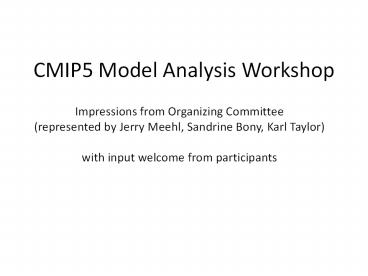CMIP5 Model Analysis Workshop - PowerPoint PPT Presentation
1 / 13
Title:
CMIP5 Model Analysis Workshop
Description:
CMIP5 Model Analysis Workshop Impressions from Organizing Committee (represented by Jerry Meehl, Sandrine Bony, Karl Taylor) with input welcome from participants – PowerPoint PPT presentation
Number of Views:126
Avg rating:3.0/5.0
Title: CMIP5 Model Analysis Workshop
1
CMIP5 Model Analysis Workshop
- Impressions from Organizing Committee
- (represented by Jerry Meehl, Sandrine Bony, Karl
Taylor) - with input welcome from participants
2
What have we learned? This is about as close as
most of us will ever get to a La Niña event
3
And we have personally experienced a La Niña
teleconnection it can be wet in Hawaii during
a La Niña event
4
In spite of some delays in model availability and
challenges in downloading model data (though
still farther along than in a similar stage for
CMIP3), analyses so far usually could include
between 15 and 22 AOGCMs, 4 to 8 decadal
prediction simulation sets, about 6 high-top
models, and 3 to 8 ESMs included in analyses, and
there is considerable interest and excitement in
analyzing model data to learn new things about
the climate system
5
The concern that the spread of future projections
from the new generation of AOGCMs with more
complexity, or from ESMs with coupled carbon
cycle, would be wildly greater than from the
AOGCMs of CMIP3 appears to have been
unfoundedspread of projections in CMIP5 AOGCMs
comparable to CMIP3, and most first generation
ESMs are well-behaved and produce comparable
first order results to AOGCMs, but with all their
additional capabilities
6
Patterns of future change of temperature and
precipitation, equilibrium climate sensitivity,
and spread among CMIP5 models similar to previous
generations of models and we have the
opportunity to better understand the spread
this increases confidence in these
results Characteristics of model simulations in
CMIP5 are either similar to CMIP3 or have
improved somewhat nothing appears to have
degraded Some quantities show considerable
improvement (e.g. rate of sea ice loss in Arctic,
reduction in cloud brightness) or a decrease in
model spread (e.g. AMOC, seasonal cycle of
precipitation in Caribbean, Greenland ice sheet
mass balance from temperature and precipitation,
Nino3 standard deviation) Some things have not
significantly improved (e.g. double ITCZ, Arctic
clouds and atmospheric circulation, Antarctic sea
ice loss, southern ocean too warm, SPCZ too
zonal, humidity in subtropical descent regimes
too high)
7
CMIP5 provides many more capabilities and new
types of climate change information -- carbon
cycle feedback, quantifying sources and sinks of
carbon for land vs ocean, allowable emissions for
different levels of mitigation in the RCP
scenarios, ocean acidification, physiological
effects of vegetation changes -- high resolution
time slices to study tropical cyclones -- decadal
climate prediction for short term climate change
and possible climate shifts --paleoclimate
simulations that allow analysis of climate
response across past, present and future
climates, and that provide out of sample
insights to build model credibility and provide
possible constraints on nature and magnitude of
future climate change --analysis of cloud
feedbacks --revisiting of forcing and feedback
better helps to interpret the spread of model
projections --attempts to relate 20th century
model biases to projections
8
New types of results, just a few examples (many
more presented) --AMO more predictable than
PDO --critical thresholds for Arctic sea ice
loss --regional climate regimes like Indian Ocean
Dipole and connections to east African
rainfall --South Pacific Convergence Zone --ocean
wave heights --changes in monsoon onset
characteristics, --role of salinity and patterns
of changes connected to hydrological cycle and
ocean response -- effects of aerosols on Atlantic
SSTs -- tracking regional ocean heat content
changes and relation to regional patterns of sea
level rise --better quantification of factors
affecting cloud feedback -- mechanisms for
regional precipitation and temperature changes
and extremesCaribbean drying, SE US wetter,
drying Amazon, connecting Arctic sea ice loss to
European cold extremes, atmospheric rivers and
extreme precipitation, importance of circulation
changes, blocking, what will not change in a
future climate is also useful information
9
Refer to the model runs as CMIP5 models, not
IPCC models or AR5 models Include
acknowledgment found at
http//cmip-pcmdi.llnl.gov/cmip5/citation.html
Refer to models by official acronyms found
at http//cmip-pcmdi.llnl.gov/cmip5/doc
s/CMIP5_modeling_groups.pdf Enter CMIP5
publication information on the PCMDI website
(coming very soon!) send publications for
assessment in AR5 directly to lead authors, or to
wg1_at_ipcc.unibe.ch, before July 31, 2012 Consult
and interact with modeling groups when you find
interesting or confusing results, or you find
anything you think will help them
understand/improve their models (can go through
PCMDI) If you want to volunteer to be a beta
tester for new ESG software system, contact
taylor13_at_llnl.gov
10
We encourage CMIP5 analysts to look at the new
classes of CMIP5 experiments that provide the
opportunity to analyze what the models
produce More model data will continue to come in
to CMIP5, so continue checking to include more
models in your multi-model results The ppt
slides from this meeting will be made available
on the password-protected web page maintained by
WCRP. In the next week or so you will receive an
email from WCRP asking your permission to post
your ppt slides. If you do not want your ppt
slide posted in this way, please respond to the
email and request your slide be removed
11
Thanks to all of you for your interest, and for
taking on the challenges of analyzing the CMIP5
model simulations to advance the state of human
knowledge of climate science
12
Thanks to all of you for your interest, and for
taking on the challenges of analyzing the CMIP5
model simulations to advance the state of human
knowledge of climate science A lot of work
has been done, and theres a lot more to do
David Karoly
13
(No Transcript)































